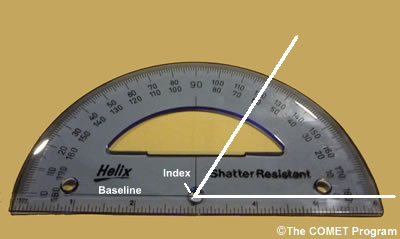Degrees are the unit of measure used for angles, just as feet are used to measure distance. The symbol for degrees is "°". There are 360° in a full circle, and 90° in a right angle. A protractor is used for measuring angles. As shown below, a protractor is a half or full circle measuring device, marked in degrees along the outer edge, with a straight line running from 0° to 180°. There is a small hole in the center of the protractor. To use a protractor:
- Place the hole of the protractor over the point of the angle where the lines meet.
- Make sure one side of the angle is on the zero line.
- Read the degrees off the protractor where the line of the other side is or mark a point along the edge at the appropriate angle measurement.

Example 1 - Part A. Measure angles 1, 2, and 3 using a protractor to follow the steps above.

You should find that the angles measure as follows:

Part B. What is the sum of angles 1 and 2? How does that number compare to angle 3?
The sum of angles 1 and 2 is 180 degrees. Angle 3 also equals 180 degrees. Angle 3 is a straight line, so it follows that the sum of angles 1 and 2, 180°, is also a straight line.
Part C. Add angles 1, 2, and 3. The sum of angles 1, 2, and 3 equals 360 degrees.
There are 360 degrees in a circle and angles 1, 2, and 3 together complete the circle.





